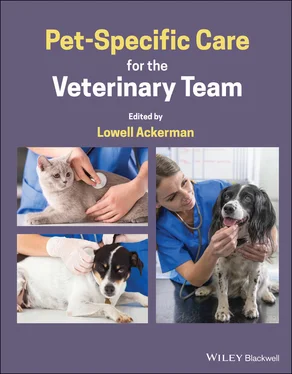Several breed organizations and/or genetic testing companies list recommended breed‐specific genetic tests and screening (see 3.7Genetic Health Registries and Research Organizations). Parent‐breed dog clubs in the US may list prebreeding screening tests through the OFA‐CHIC program ( www.ofa.org/browse‐by‐breed) and AKC Breed with HEART program ( www.akc.org/breeder‐programs/akc‐bred‐with‐heart‐program/requirements/health‐testing‐requirements). For cat breeds, International Cat Care lists breed‐specific genetic diseases ( https://icatcare.org/advice/?per_page=12&categories=cat‐breeds).
3.6.5 Availability of Genetic Tests
The quantity and commercial availability of DNA‐based genetic tests are rapidly increasing. A regularly updated list of available mutation‐based and linked marker‐based genetic tests is available at: http://research.vet.upenn.edu/WSAVA‐LabSearch. For canine genetic tests, the International Partnership for Dogs has a similar database that includes quality control metrics of laboratories: https://dogwellnet.com/ctp. Unfortunately, companies offering DNA testing are unregulated and may have no established standards for quality control or validation of the genetic test results that they report.
3.6.5.1 Genetic Panel (Multiplex) Testing
Several commercial genetic testing laboratories offer breed‐specific “panels” of DNA tests versus running individual tests. However, in many instances, tests may be offered that have no relevance to causing clinical disease in a specific breed. A test may be offered based on a single published report, from a research colony, or from a related breed. Test results are of no consequence if a disease is not clinically documented in the specific breed population. Sources should be consulted to identify valid genetic tests in each breed.
Some commercial laboratories have developed gene chips that test for hundreds of SNPs from a single DNA sample (usually a cheek swab). This is far more cost and time efficient than sending out DNA samples to multiple laboratories for individual gene tests. If a SNP is the sole cause of the disease, then these are direct genetic tests. However, many of these SNPs are associated with a larger mutation and so are actually linked marker tests. These are susceptible to false‐positive and ‐negative results. If decisions of treatment or breeding are being made, they should be based on direct mutation tests.
While multiplex (panel) testing provides a more cost‐efficient way to do genetic testing, the majority of individual SNP results are of no consequence except to single breeds or subsets of breeds. There are many mutations that cause disease in one or a few breeds, however the mutation is present in many other breeds and does not cause clinical disease. This is because in the other breeds, additional mutations are not present that make the testable mutation a disease‐causing gene. The sod1 mutation for degenerative myelopathy and the cord1 PRA mutations are examples of liability genes that contribute to disease in only a handful of breeds but may be detectable in almost all breeds. A carrier or even “affected” test result for these mutations must be ignored in breeds not prone to the specific disorder.
3.6.5.2 Mixed‐Breed and Purebred Testing
Several companies offer DNA testing to identify breed heritage for pets. Unfortunately, only a few companies have actually performed the research to do this kind of analysis accurately. There are several companies that run these tests based on limited published guidelines and produce spurious results. Another issue is that these tests were designed to answer the question, “If this dog descended from only purebred ancestors, what breeds were represented?” Most mixed‐breed dogs are not descended from purebred ancestors (except designer breeds) and come from multiple generations of mixed‐breed ancestors. In the majority of cases the testing will identify markers that are considered breed specific and label that breed as an ancestor. It is more likely that the tested dog's ancestor and the founding members of a breed shared a marker – not that the pet's ancestor descended from the breed. For example, several “hound‐type” mixed‐breed dogs will be identified as being descended from rare hound breeds such as American foxhound or blue tick coonhound when the testing is just identifying markers that are present in ancestors to hound breeds. Even genetic testing companies that have done extensive research into mixed‐breed testing will have conflicting results on the same DNA sample. These are “best‐guess” results based on each company's algorithm of estimating breed background.
3.6.5.3 Genetic Diversity Testing
There are several genetic testing laboratories that will calculate inbreeding and genetic diversity indexes on purebred dogs or cats and make recommendations to increase heterozygosity. These are based on guidelines that are valid in endangered species preservation, but not in purebred dog or pedigree cat breeding. The gene dynamics of endangered species and purebred dog and cat breeding are directly opposite from each other.
The basis of creating a breed is selection and genetic uniformity and the basis of endangered species preservation is the randomization of genes through mating the most unrelated individuals together. Some breeds are more ancient and have larger measured genetic diversity while more recently formed breeds with smaller populations may have lower measured genetic diversity. The larger population breeds with greater measured diversity once looked like the smaller population breeds when they first began to grow their population. The size of the gene pool and measured genetic diversity does not correlate to genetic health, as this is based on the presence of disease liability genes. Some genetic testing laboratories test for MHC genes as a measurement of genetic diversity and the immune system. However, no immune‐related or autoimmune diseases are shown to be caused by a decrease of MHC diversity. They are caused by specific mutations or alleles in the MHC that predispose to disease with one or two copies of a mutation.
3.6.5.4 Estimated Breeding Values
Taking a cue from large animal production methods, dogs and cats can be rated for complex genetic disease liability through the phenotypic assessment of their close relatives. This is being attempted with hip dysplasia in several dog breeds. However, valid estimated breeding values (EBVs) require the assessment of all close relatives (including all littermates), which is rarely done in dog and cat breeding. The identification of one affected relative or of one normal relative can significantly shift EBVs when full litter assessment would provide a different rating. If EBVs are being offered, they can be used as a tool in addition to direct assessment of the phenotype of the individual and its close relatives.
3.6.5.5 Genomic Breeding Values
Researchers are working on ratings for dogs and cats with complexly inherited diseases based on a panel of DNA markers that are found to differ between groups of affected and normal individuals. These panels of markers are only validated in a small group within individual breeds, and, at least at the present time, lose their validation when applied to larger populations within a breed. However, this approach to genetic testing for disease liability shows promise as the science continues to develop.
Advances in genetic research are providing genetic tests for pathology and biopsy specimens. These tests can provide more specific prognostic and differential treatment recommendations for many types of cancer (see 2.20Cancer Precision Medicine), liver disease, hematological disorders, etc.
Читать дальше












